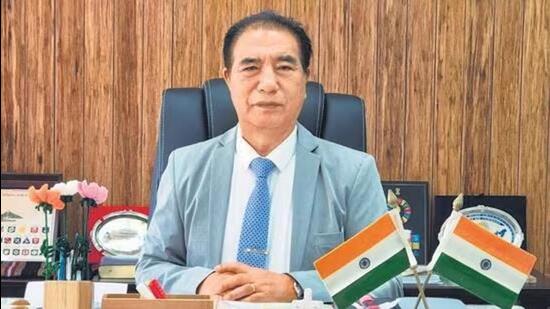Western Involvement in Myanmar Unrest: A Geopolitical Game Spilling into India’s Northeast
MIZORAMOPINION & ANALYSIS
Aizawl, Mizoram: In a startling revelation that has sent ripples through India’s northeastern region and beyond, Mizoram Chief Minister Lalduhoma dropped a bombshell during a session of the state legislative assembly on Monday, March 10, 2025. He disclosed that individuals from the United States and the United Kingdom have been entering Myanmar via Mizoram to provide arms training and logistical support to anti-junta rebel groups. This admission not only underscores the escalating unrest in Myanmar but also raises provocative questions about Western intentions in the region—potentially aimed at establishing a strategic foothold between Myanmar, Bangladesh, and India through the creation of an independent Christian state to counterbalance Chinese influence.This bombshell, however, is not the first indication of foreign meddling in the region’s unrest.


The earliest public revelation of the USA’s intent to establish a strategic base in the region came from Sheikh Hasina, then Prime Minister of Bangladesh, who in June 2023 alleged a Western conspiracy to carve out a Christian state from parts of Bangladesh and Myanmar—potentially as a foothold to counter China’s regional dominance.
Meanwhile, Manipur Chief Minister N. Biren Singh was among the first to flag external forces sustaining unrest in Manipur, a claim dismissed by many at the time but now gaining credence amid mounting evidence.
Sheikh Hasina’s Warning and the St. Martin’s Precedent
Sheikh Hasina’s June 2023 statement to Awami League leaders was a geopolitical thunderclap. She warned of a plot to create “a Christian state like East Timor” by annexing territory from Bangladesh, particularly the St. Martin’s Island—a strategically vital coral island in the Bay of Bengal—potentially serving as a military base for the US. Hasina, who resisted American pressure to cede control of the island, framed this as part of a broader scheme to destabilize the region and offset China’s influence. Her allegations, though denied by the US State Department as “not accurate,” hinted at a Western design that now finds echoes in Myanmar’s turmoil and its spillover into India’s northeast.
Foreign Hands in Myanmar’s Conflict
Lalduhoma’s assembly address brought concrete evidence to these suspicions. He cited the arrest of Daniel Newey, a UK national apprehended on June 19, 2024, at Lengpui Airport with live ammunition, as a case in point. Newey, acquitted in February 2025, was part of a larger pattern, with Lalduhoma noting that some foreigners entering Myanmar via Mizoram had combat experience from the Russia-Ukraine war.
“Some people, including those from the US and UK, entered Myanmar via Mizoram and were engaged in arms training of the insurgent groups in the neighboring country,” he stated, underscoring Mizoram’s role as a transit hub.
Nearly 2,000 foreigners visited Aizawl between June and December 2024, many vanishing from public view, fueling fears of covert operations. The Indian Ministry of Home Affairs (MHA) responded by reimposing the Protected Area Permit (PAP) regime in December 2024 across Mizoram, Manipur, and Nagaland, reversing a 14-year relaxation to curb such movements amid heightened geopolitical stakes.
Biren Singh’s Early Alarm and Manipur’s Unrest
Across the border in Manipur, Chief Minister N. Biren Singh had long sounded the alarm on external interference. As early as 2023, amid escalating ethnic violence between the Meitei and Kuki-Zo communities, Singh pointed to “foreign hands” exacerbating the crisis—a claim met with skepticism then but now increasingly validated. The arrest of a Myanmar-based Kuki National Army (Burma) cadre by Assam Rifles in September 2024 lent weight to his assertions, with Singh stating, “I have been consistently claiming from the beginning that the current crisis in Manipur is due to outsiders, foreign hands.” The unrest, which has claimed over 258 lives since May 2023, has been linked to illegal immigration from Myanmar and the arming of tribal militias, with fingers pointing to Western support funneled through porous borders.
A Strategic Christian State?
The notion of a Western-backed Christian state uniting Myanmar’s Chin State, India’s Mizoram and Manipur, and parts of Bangladesh has gained traction. Lalduhoma’s brokering of a February 2025 peace deal between Chin rebel factions in Aizawl, alongside his September 2024 US speech advocating Zo (Chin-Kuki-Mizo) reunification “under one leadership,” has stoked speculation.
Critics, including Manipur’s leadership, see this as aligning with a broader agenda—potentially Western-orchestrated—to establish a buffer against China. The Christian-majority Chin rebels, bolstered by external aid, have made significant gains against Myanmar’s junta, with ripple effects felt in Manipur’s Kuki-Zo unrest and Mizoram’s refugee influx.
This aligns with Hasina’s warnings and Singh’s concerns, suggesting a coordinated effort to reshape the region’s geopolitics. A Christian state could disrupt China’s Belt and Road projects in Myanmar while giving the West a strategic base between India, Bangladesh, and Myanmar—echoing Hasina’s St. Martin’s fears.
Spillover and India’s Response
Manipur’s crisis, intertwined with Myanmar’s instability, has seen refugee flows and arms smuggling intensify ethnic tensions. The MHA’s PAP reimposition and plans to fence the 1,643-kilometer India-Myanmar border reflect New Delhi’s urgency to contain the fallout. Lalduhoma, while opposing the scrapping of the Free Movement Regime (FMR) for ethnic Mizos, acknowledged the Centre’s security imperatives, noting, “The situation in our neighboring country is being closely viewed by different countries, including China and the US.”
The unannounced visit of the US Ambassador to Mizoram in 2024 further heightened suspicions of American interest, catching the state government off guard. Meanwhile, Singh’s warnings of demographic changes due to illegal immigration—once dismissed—are now central to India’s border security strategy.
Geopolitical Chessboard
The threads of Hasina’s 2023 revelation, Singh’s early alerts, and Lalduhoma’s recent disclosures weave a complex tapestry of foreign intrigue. The US and UK’s alleged support for Myanmar’s rebels—via Mizoram—suggests a bid to counter China, with India’s northeast as collateral damage. While New Delhi backs Myanmar’s junta to balance Beijing, Western powers appear to favor the anti-junta resistance, placing India in a strategic bind.
The idea of an independent Christian state remains speculative but plausible, given the region’s Christian demographics and ethnic ties. Lalduhoma’s Zo reunification rhetoric, though framed as cultural, risks feeding into this narrative, while Singh’s insistence on territorial integrity reflects India’s resistance to such designs.
Unanswered Questions
As Myanmar’s civil war spills across borders, the roles of Hasina, Singh, and Lalduhoma illuminate a shadowy geopolitical contest. Was Hasina’s ouster in August 2024 tied to her defiance of US ambitions? Did Singh’s early warnings foreshadow a deeper conspiracy? And is Lalduhoma unwittingly—or wittingly—advancing a Western agenda? For now, India’s northeast remains a crucible of unrest, where local conflicts intersect with global rivalries, leaving the region’s future hanging in the balance.
